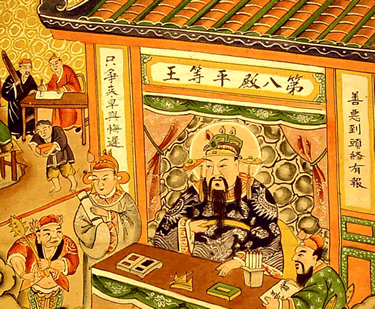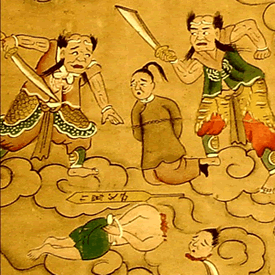The Ten Magistrates of the Underworld Realm
According to Chinese popular religion, there are three domains in the cosmos — Heaven, Earth, and the Underworld — and each domain is populated by a host of important gods and goddesses. The Underworld Domain is where the souls of the deceased are held accountable for their actions in life. All souls receive their “final judgment” in the Underworld Domain, after which they are reincarnated.
THE SOUL’S JOURNEY THROUGH THE UNDERWORLD REALM
Although partially derived from Buddhism, the Underworld in its Chinese form had long been assimilated into the hierarchical framework of popular religion and was seen as the domain of ten judges or Magistrates of Hell. This domain was a transitory space and time for the souls of the dead and could not properly be called “hell” in the Christian sense of a place of perpetual punishment for a permanent, unchanging self. Still, the domain of the ten magistrates was a place where souls were held accountable for their actions in life and had to submit to sometimes horrible punishments.
The few who had led exemplary lives could hope to obtain early or even immediate release from the Underworld realm and enter either the blissful “Western Pure Land” of the Buddha Amitābha or the Heaven of the Jade Emperor, but the majority had to go before all ten Hell Magistrates and atone for their misdeeds in life. The basic conduct of mourning and funerary rituals was carried on with this assumption: that very few people, if any, obtain an “early release” from the Underworld for having lived an unusually virtuous life. Thus, the point of the rituals was to get the deceased through the ten Courts of Hell as quickly as possible.
The Underworld was thought to be a vast duplicate or alternate version of the Earthly realm, complete with houses and furniture, streets and gardens, and of course teeming with souls “passing through” on their way to being reincarnated back into the world of the living. These waiting souls were taken care of by their living descendants, who burned paper offerings to them at their funerals. The paper offerings included items such as houses, horses, and money and were meant to ensure that the soul of the deceased would have a “pleasant stay” in the Underworld realm and enjoy the same trappings of life there that the living enjoyed in the Earthly realm.
THE TEN BUREAUCRATS OF HELL?: THE MAGISTRATES IN THE POPULAR IMAGINATION
The popular conception of the ten Magistrates of Hell was modeled on bureaucrats of the imperial government. Each magistrate had control over a specific domain — a separate “hell” — just as a county magistrate in the imperial system had his own domain, separate from that of the other county magistrates. And just as the imperial bureaucrat had his own staff, the Underworld Magistrate was surrounded by ferocious lictors who aided in the execution of the various punishments. In paintings the Underworld Magistrates were depicted almost exactly like government magistrates, so that they even had “offices” that looked just like the offices of earthly government magistrates. [More on how the Chinese conception of gods is based on the Chinese bureaucracy...]
CRIME AND PUNISHMENT: POPULAR DEPICTIONS OF THE TEN COURTS OF HELL
The various punishments inflicted by the Hell Magistrates’ lictors, along with the layout of the ten (or eighteen, by some accounts) hells of the Underworld, were very commonly known in late-imperial China. Every City God temple had depictions of the Courts of Hell that included graphic representations of the harshest, most gruesome punishments allotted to sinners. Visitors to the temple would see a depiction of, for example, a grain merchant cheating on his weights, next to a depiction of the same merchant’s soul in one of the courts of hell being crushed by the very weight measures that he had distorted in his life.
THE TENTH COURT OF HELL: FINAL JUDGMENT AND REINCARNATION FOR ALL
At the tenth and final court of hell souls received their final judgment and were reincarnated. Some were reincarnated as animals, as punishment for bad behavior; others were reincarnated as human beings, but given a more or less favorable social position than in their past life, depending on how virtuous they had been in that life. Before reincarnation occurred, according to many popular accounts, a woman called “Aunt Meng” forced the soul to drink a kind of potion for forgetting the previous life.
No matter how sinful a soul had been, punishment in the Underworld realm was not eternal, and with the exception of the very few who were virtuous enough to gain entry into the “Pure Land of the West,” all souls were eventually reincarnated. In this way the originally Buddhist idea of the unending cycle of life, death, and rebirth (saṃsāra) was prominently incorporated into popular notions of cosmic continuity and cosmic reproduction.

